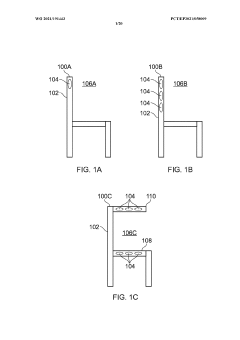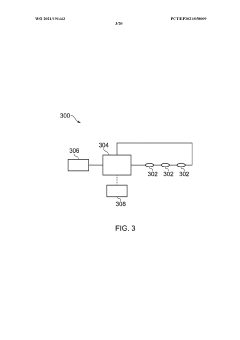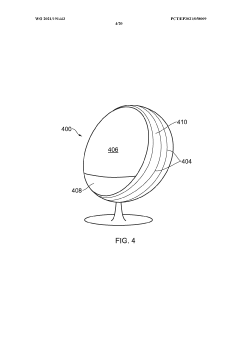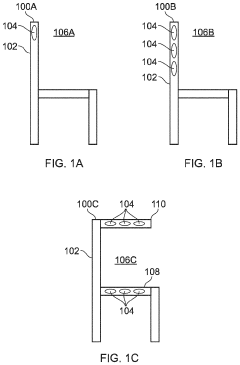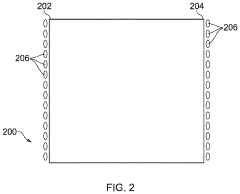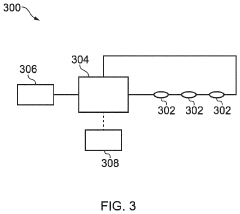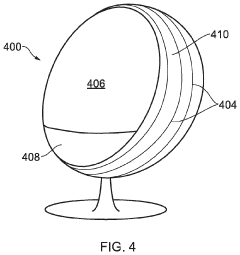Schumann Resonance in Atmospheric Sciences: Current Applications
JUN 24, 20259 MIN READ
Generate Your Research Report Instantly with AI Agent
Patsnap Eureka helps you evaluate technical feasibility & market potential.
Schumann Resonance Background and Objectives
Schumann resonances, first predicted by Winfried Otto Schumann in 1952, are a set of spectrum peaks in the extremely low frequency (ELF) portion of the Earth's electromagnetic field spectrum. These resonances occur in the Earth-ionosphere cavity, a waveguide formed between the Earth's surface and the ionosphere. The fundamental frequency of Schumann resonances is approximately 7.83 Hz, with harmonics at higher frequencies.
The study of Schumann resonances has evolved significantly since their discovery, becoming an essential tool in atmospheric sciences. Initially, these resonances were primarily of interest to physicists and radio engineers. However, their applications have expanded to various fields within atmospheric sciences, including global lightning activity monitoring, climate change studies, and space weather research.
The primary objective of studying Schumann resonances in atmospheric sciences is to gain insights into global atmospheric processes and their interactions with the Earth's electromagnetic environment. These resonances serve as a natural global electromagnetic background, providing a unique perspective on large-scale atmospheric phenomena.
One of the key goals is to utilize Schumann resonances for monitoring global lightning activity. As lightning strikes are the primary excitation source for these resonances, variations in their amplitude and frequency can provide valuable information about global thunderstorm activity and its distribution. This data is crucial for understanding the Earth's electrical circuit and its role in various atmospheric processes.
Another important objective is to investigate the potential of Schumann resonances as indicators of climate change. Long-term variations in these resonances may reflect changes in global temperature, humidity, and other climate-related parameters. Researchers aim to establish correlations between Schumann resonance characteristics and climate variables to develop new tools for climate monitoring and prediction.
Furthermore, the study of Schumann resonances aims to enhance our understanding of the ionosphere's dynamics and its response to solar activity. By analyzing changes in resonance parameters, scientists can gain insights into ionospheric disturbances caused by solar flares, geomagnetic storms, and other space weather events.
In recent years, there has been growing interest in exploring the potential applications of Schumann resonances in fields beyond atmospheric sciences, such as human health and cognition. While these areas remain controversial and require further research, they highlight the interdisciplinary nature of Schumann resonance studies and their potential for broader scientific impact.
The study of Schumann resonances has evolved significantly since their discovery, becoming an essential tool in atmospheric sciences. Initially, these resonances were primarily of interest to physicists and radio engineers. However, their applications have expanded to various fields within atmospheric sciences, including global lightning activity monitoring, climate change studies, and space weather research.
The primary objective of studying Schumann resonances in atmospheric sciences is to gain insights into global atmospheric processes and their interactions with the Earth's electromagnetic environment. These resonances serve as a natural global electromagnetic background, providing a unique perspective on large-scale atmospheric phenomena.
One of the key goals is to utilize Schumann resonances for monitoring global lightning activity. As lightning strikes are the primary excitation source for these resonances, variations in their amplitude and frequency can provide valuable information about global thunderstorm activity and its distribution. This data is crucial for understanding the Earth's electrical circuit and its role in various atmospheric processes.
Another important objective is to investigate the potential of Schumann resonances as indicators of climate change. Long-term variations in these resonances may reflect changes in global temperature, humidity, and other climate-related parameters. Researchers aim to establish correlations between Schumann resonance characteristics and climate variables to develop new tools for climate monitoring and prediction.
Furthermore, the study of Schumann resonances aims to enhance our understanding of the ionosphere's dynamics and its response to solar activity. By analyzing changes in resonance parameters, scientists can gain insights into ionospheric disturbances caused by solar flares, geomagnetic storms, and other space weather events.
In recent years, there has been growing interest in exploring the potential applications of Schumann resonances in fields beyond atmospheric sciences, such as human health and cognition. While these areas remain controversial and require further research, they highlight the interdisciplinary nature of Schumann resonance studies and their potential for broader scientific impact.
Market Demand for SR Applications
The market demand for Schumann Resonance (SR) applications in atmospheric sciences has been steadily growing in recent years. This increasing interest is driven by the unique capabilities of SR measurements to provide global-scale information about the Earth's electromagnetic environment and its interactions with various atmospheric phenomena.
One of the primary market drivers for SR applications is the field of climate monitoring and research. As climate change continues to be a pressing global issue, scientists and policymakers are seeking more comprehensive and accurate methods to monitor and understand atmospheric dynamics. SR measurements offer valuable insights into global lightning activity, which is closely linked to temperature and precipitation patterns. This has led to increased demand from meteorological agencies, climate research institutions, and environmental monitoring organizations for SR-based monitoring systems.
The telecommunications industry has also shown growing interest in SR applications. SR measurements can provide information about ionospheric disturbances, which can affect radio wave propagation and satellite communications. As our reliance on wireless communication technologies continues to expand, there is a rising demand for tools that can help predict and mitigate ionospheric effects on signal transmission.
In the field of natural disaster prediction and early warning systems, SR applications have gained traction. Researchers have found correlations between SR anomalies and seismic activity, potentially offering a new avenue for earthquake prediction. This has sparked interest from geological survey agencies and disaster management organizations, creating a niche market for SR-based earthquake monitoring systems.
The aerospace industry has also recognized the potential of SR applications. SR measurements can provide valuable data on space weather phenomena, which can impact satellite operations and astronaut safety. As space exploration and satellite-based services continue to expand, there is an increasing demand for tools to monitor and predict space weather events.
In the realm of health sciences, there is a growing market for SR applications in studying the potential effects of extremely low frequency electromagnetic fields on human health. This has led to interest from medical research institutions and health organizations in SR monitoring equipment for long-term epidemiological studies.
While the market for SR applications is still relatively specialized, it shows promising growth potential. The interdisciplinary nature of SR research means that demand comes from a diverse range of sectors, including atmospheric sciences, telecommunications, disaster management, aerospace, and health sciences. As awareness of SR's potential applications grows and technology advances, we can expect to see an expansion in both the range of applications and the size of the market for SR-based tools and services.
One of the primary market drivers for SR applications is the field of climate monitoring and research. As climate change continues to be a pressing global issue, scientists and policymakers are seeking more comprehensive and accurate methods to monitor and understand atmospheric dynamics. SR measurements offer valuable insights into global lightning activity, which is closely linked to temperature and precipitation patterns. This has led to increased demand from meteorological agencies, climate research institutions, and environmental monitoring organizations for SR-based monitoring systems.
The telecommunications industry has also shown growing interest in SR applications. SR measurements can provide information about ionospheric disturbances, which can affect radio wave propagation and satellite communications. As our reliance on wireless communication technologies continues to expand, there is a rising demand for tools that can help predict and mitigate ionospheric effects on signal transmission.
In the field of natural disaster prediction and early warning systems, SR applications have gained traction. Researchers have found correlations between SR anomalies and seismic activity, potentially offering a new avenue for earthquake prediction. This has sparked interest from geological survey agencies and disaster management organizations, creating a niche market for SR-based earthquake monitoring systems.
The aerospace industry has also recognized the potential of SR applications. SR measurements can provide valuable data on space weather phenomena, which can impact satellite operations and astronaut safety. As space exploration and satellite-based services continue to expand, there is an increasing demand for tools to monitor and predict space weather events.
In the realm of health sciences, there is a growing market for SR applications in studying the potential effects of extremely low frequency electromagnetic fields on human health. This has led to interest from medical research institutions and health organizations in SR monitoring equipment for long-term epidemiological studies.
While the market for SR applications is still relatively specialized, it shows promising growth potential. The interdisciplinary nature of SR research means that demand comes from a diverse range of sectors, including atmospheric sciences, telecommunications, disaster management, aerospace, and health sciences. As awareness of SR's potential applications grows and technology advances, we can expect to see an expansion in both the range of applications and the size of the market for SR-based tools and services.
Current State and Challenges in SR Research
Schumann Resonance (SR) research has made significant strides in recent years, with applications expanding across various atmospheric science disciplines. Currently, SR measurements are widely used for global lightning activity monitoring, providing valuable insights into the Earth's electric circuit and climate change impacts. Advanced detection techniques have improved the accuracy and reliability of SR data collection, enabling researchers to extract more detailed information about atmospheric processes.
Despite these advancements, several challenges persist in SR research. One major obstacle is the difficulty in isolating SR signals from anthropogenic electromagnetic noise, particularly in urban areas. This interference can significantly impact the quality of measurements and limit the potential applications of SR in densely populated regions. Researchers are actively developing more sophisticated filtering algorithms and noise reduction techniques to address this issue.
Another challenge lies in the interpretation of SR data in relation to complex atmospheric phenomena. While SR measurements offer a global perspective on lightning activity, correlating these observations with specific meteorological events or climate patterns remains a complex task. The multifaceted nature of atmospheric processes often makes it challenging to establish direct causal relationships between SR variations and specific environmental changes.
The geographical distribution of SR monitoring stations presents an additional hurdle. While there has been an increase in the number of stations worldwide, there are still significant gaps in coverage, particularly in remote and oceanic regions. This uneven distribution can lead to biases in global SR assessments and limit the ability to conduct comprehensive studies of atmospheric dynamics on a truly global scale.
Furthermore, the integration of SR data with other atmospheric and geophysical measurements remains a significant challenge. While SR observations provide unique insights, their full potential can only be realized when combined with data from other sources, such as satellite imagery, radar systems, and ground-based sensors. Developing robust methodologies for data fusion and cross-validation is an ongoing area of research that requires further attention.
Lastly, the long-term stability and calibration of SR measurement systems pose challenges for longitudinal studies. As SR research increasingly focuses on detecting subtle changes in the Earth's electromagnetic environment over extended periods, ensuring consistent and comparable measurements across different instruments and locations becomes crucial. Standardization efforts are underway, but achieving global consensus on measurement protocols and data processing techniques remains a work in progress.
Despite these advancements, several challenges persist in SR research. One major obstacle is the difficulty in isolating SR signals from anthropogenic electromagnetic noise, particularly in urban areas. This interference can significantly impact the quality of measurements and limit the potential applications of SR in densely populated regions. Researchers are actively developing more sophisticated filtering algorithms and noise reduction techniques to address this issue.
Another challenge lies in the interpretation of SR data in relation to complex atmospheric phenomena. While SR measurements offer a global perspective on lightning activity, correlating these observations with specific meteorological events or climate patterns remains a complex task. The multifaceted nature of atmospheric processes often makes it challenging to establish direct causal relationships between SR variations and specific environmental changes.
The geographical distribution of SR monitoring stations presents an additional hurdle. While there has been an increase in the number of stations worldwide, there are still significant gaps in coverage, particularly in remote and oceanic regions. This uneven distribution can lead to biases in global SR assessments and limit the ability to conduct comprehensive studies of atmospheric dynamics on a truly global scale.
Furthermore, the integration of SR data with other atmospheric and geophysical measurements remains a significant challenge. While SR observations provide unique insights, their full potential can only be realized when combined with data from other sources, such as satellite imagery, radar systems, and ground-based sensors. Developing robust methodologies for data fusion and cross-validation is an ongoing area of research that requires further attention.
Lastly, the long-term stability and calibration of SR measurement systems pose challenges for longitudinal studies. As SR research increasingly focuses on detecting subtle changes in the Earth's electromagnetic environment over extended periods, ensuring consistent and comparable measurements across different instruments and locations becomes crucial. Standardization efforts are underway, but achieving global consensus on measurement protocols and data processing techniques remains a work in progress.
Existing SR Measurement Techniques
01 Schumann resonance-based therapeutic devices
Various therapeutic devices have been developed that utilize Schumann resonance frequencies for health and wellness purposes. These devices aim to simulate the natural electromagnetic frequencies of the Earth to promote relaxation, improve sleep quality, and enhance overall well-being. Some designs incorporate wearable technology or portable units that can generate Schumann resonance frequencies for personal use.- Schumann resonance devices for health and wellness: Various devices are designed to generate or utilize Schumann resonance frequencies for potential health benefits. These devices aim to simulate the natural electromagnetic frequencies of the Earth to promote relaxation, improve sleep quality, and enhance overall well-being. Some implementations include wearable devices, room-based generators, and portable units that emit Schumann resonance frequencies.
- Schumann resonance in environmental monitoring and prediction: Schumann resonance measurements are used in environmental monitoring systems and prediction models. These applications leverage the relationship between Schumann resonance and global lightning activity, atmospheric conditions, and climate patterns. The technology can be applied in weather forecasting, climate change studies, and early warning systems for natural disasters.
- Integration of Schumann resonance in meditation and relaxation tools: Schumann resonance frequencies are incorporated into meditation and relaxation tools to enhance the user experience. These tools may include audio devices, virtual reality systems, or specialized meditation spaces that generate or simulate Schumann resonance frequencies. The aim is to create an environment that promotes deeper relaxation and potentially facilitates meditative states.
- Schumann resonance in electromagnetic shielding and protection: Technologies are developed to incorporate Schumann resonance principles in electromagnetic shielding and protection devices. These innovations aim to protect individuals from harmful electromagnetic radiation while maintaining exposure to beneficial Schumann resonance frequencies. Applications include protective clothing, building materials, and personal electronic device accessories.
- Schumann resonance applications in agriculture and plant growth: Schumann resonance frequencies are applied in agricultural technologies to potentially enhance plant growth and crop yields. These applications involve exposing plants to simulated Schumann resonance frequencies through specialized equipment or modified growing environments. The technology aims to optimize plant health, growth rates, and overall agricultural productivity.
02 Environmental simulation systems
Systems have been designed to recreate Schumann resonance conditions in enclosed spaces such as buildings, vehicles, or spacecraft. These systems aim to counteract the shielding effects of modern structures and provide occupants with exposure to beneficial electromagnetic frequencies. Some implementations include integrated air purification and lighting systems to create a more comprehensive simulated natural environment.Expand Specific Solutions03 Schumann resonance measurement and analysis
Specialized equipment and methods have been developed for measuring and analyzing Schumann resonance frequencies. These tools are used for scientific research, environmental monitoring, and potential applications in earthquake prediction. Some devices are designed for portable use, allowing for field measurements and data collection in various locations.Expand Specific Solutions04 Integration with meditation and relaxation aids
Schumann resonance technology has been incorporated into various meditation and relaxation aids. These products may include specially designed seating, audio systems, or immersive environments that combine Schumann resonance frequencies with other relaxation techniques. The goal is to enhance the effectiveness of meditation practices and promote deeper states of relaxation.Expand Specific Solutions05 Agricultural and plant growth applications
Research has explored the potential benefits of Schumann resonance frequencies on plant growth and agricultural productivity. Systems have been developed to expose crops or indoor plants to these frequencies, aiming to enhance growth rates, improve crop yields, or increase plant resilience. Some designs incorporate Schumann resonance generators into greenhouse or hydroponic systems.Expand Specific Solutions
Key Players in SR Research and Applications
The field of Schumann Resonance in Atmospheric Sciences is currently in a growth phase, with increasing applications and research interest. The market size for related technologies and applications is expanding, driven by advancements in atmospheric monitoring and climate research. The technology's maturity varies across different applications, with some areas more developed than others. Key players like Massachusetts Institute of Technology, Naval Research Laboratory, and The Johns Hopkins University are at the forefront of research and development. Companies such as Vaisala Oyj and BAE Systems are leveraging this technology for commercial applications, while institutions like the University of Bern and Wuhan University of Technology are contributing to academic advancements. The competitive landscape is diverse, with a mix of academic institutions, government laboratories, and private companies driving innovation in this field.
Naval Research Laboratory
Technical Solution: The Naval Research Laboratory has developed advanced techniques for monitoring and analyzing Schumann Resonances in the Earth-ionosphere cavity. Their approach involves using a network of sensitive magnetometers and sophisticated signal processing algorithms to detect and characterize these low-frequency electromagnetic waves. The NRL's system can distinguish between natural Schumann Resonances and man-made electromagnetic interference, providing valuable data for atmospheric and space weather studies. Additionally, they have explored the potential use of Schumann Resonances for long-range communication and navigation systems.
Strengths: Highly sensitive detection capabilities, advanced signal processing techniques, and potential for dual-use applications. Weaknesses: Limited global coverage due to the need for specialized equipment and potential interference from human activities.
Massachusetts Institute of Technology
Technical Solution: MIT researchers have developed a novel approach to studying Schumann Resonances using a combination of ground-based and satellite-based measurements. Their method involves correlating data from multiple sources, including ground-based ELF receivers and satellite-based electric field sensors, to create a comprehensive picture of global electromagnetic activity. This multi-platform approach allows for more accurate characterization of Schumann Resonances and their variations due to solar activity, lightning, and other atmospheric phenomena. MIT's research also explores the potential use of Schumann Resonances as a tool for monitoring global climate change and detecting precursors to large-scale weather events.
Strengths: Comprehensive multi-platform approach, potential for global climate monitoring. Weaknesses: Complexity of data integration and interpretation, reliance on multiple data sources.
Core Innovations in SR Analysis
A magnetic field exposure system and uses thereof
PatentWO2021191443A1
Innovation
- A magnetic field exposure system generating an amplitude-modulated low frequency magnetic field with a carrier frequency of 360 to 450 Hz and a modulation frequency of 0.5 to 100 Hz, with a field strength of 0.5 to 250 mT, specifically designed to expose organic cells or tissues to improve cell survival, proliferation, reduce stress, and enhance well-being.
A magnetic field exposure system and uses thereof
PatentPendingUS20230372726A1
Innovation
- A magnetic field exposure system generating an amplitude-modulated low frequency magnetic field with a carrier frequency of 360 to 450 Hz and a modulation frequency of 0.5 to 100 Hz, providing a field strength of 0.5 to 250 μT, specifically designed to enhance cell survival, proliferation, reduce stress, and promote tissue regeneration.
Environmental Impact of SR Studies
The environmental impact of Schumann Resonance (SR) studies has become increasingly significant in recent years, as researchers explore the intricate relationships between these natural electromagnetic phenomena and various ecological systems. SR, a set of spectral peaks in the Earth's electromagnetic field spectrum, has been found to have far-reaching implications for atmospheric sciences and environmental monitoring.
One of the primary environmental impacts of SR studies lies in their potential to serve as indicators of global climate change. Researchers have observed correlations between SR frequency variations and large-scale meteorological phenomena, such as El Niño events and global temperature fluctuations. This connection provides a unique tool for monitoring long-term climate trends and understanding the complex interactions between the Earth's atmosphere and its electromagnetic environment.
SR studies have also shed light on the potential effects of human activities on the Earth's electromagnetic field. Industrial activities, urbanization, and the proliferation of wireless communication technologies have been shown to influence local SR measurements. This insight has prompted further investigation into the possible ecological consequences of anthropogenic electromagnetic pollution and its impact on natural ecosystems.
In the realm of biodiversity conservation, SR research has revealed intriguing connections between electromagnetic fields and animal behavior. Some species, particularly migratory birds and marine mammals, appear to use the Earth's natural electromagnetic field for navigation. Changes in SR patterns could potentially disrupt these natural navigation systems, highlighting the importance of preserving the integrity of the Earth's electromagnetic environment.
Furthermore, SR studies have contributed to our understanding of the ionosphere's role in atmospheric chemistry and air quality. The ionosphere, which plays a crucial part in SR generation, is sensitive to solar activity and atmospheric composition. By monitoring SR parameters, scientists can gain insights into ionospheric dynamics and their influence on atmospheric processes, including the formation and distribution of air pollutants.
The application of SR measurements in earthquake prediction and monitoring represents another significant environmental impact. While still a developing field, some researchers have reported correlations between SR anomalies and seismic activity. If further validated, this could lead to improved early warning systems for natural disasters, potentially mitigating their environmental and human impact.
In conclusion, the environmental impact of SR studies extends far beyond academic interest, offering valuable tools for monitoring global environmental changes, assessing human impacts on natural electromagnetic fields, and potentially improving our ability to predict and respond to environmental challenges. As research in this field continues to advance, it is likely to play an increasingly important role in shaping our understanding of Earth's complex environmental systems and informing sustainable management practices.
One of the primary environmental impacts of SR studies lies in their potential to serve as indicators of global climate change. Researchers have observed correlations between SR frequency variations and large-scale meteorological phenomena, such as El Niño events and global temperature fluctuations. This connection provides a unique tool for monitoring long-term climate trends and understanding the complex interactions between the Earth's atmosphere and its electromagnetic environment.
SR studies have also shed light on the potential effects of human activities on the Earth's electromagnetic field. Industrial activities, urbanization, and the proliferation of wireless communication technologies have been shown to influence local SR measurements. This insight has prompted further investigation into the possible ecological consequences of anthropogenic electromagnetic pollution and its impact on natural ecosystems.
In the realm of biodiversity conservation, SR research has revealed intriguing connections between electromagnetic fields and animal behavior. Some species, particularly migratory birds and marine mammals, appear to use the Earth's natural electromagnetic field for navigation. Changes in SR patterns could potentially disrupt these natural navigation systems, highlighting the importance of preserving the integrity of the Earth's electromagnetic environment.
Furthermore, SR studies have contributed to our understanding of the ionosphere's role in atmospheric chemistry and air quality. The ionosphere, which plays a crucial part in SR generation, is sensitive to solar activity and atmospheric composition. By monitoring SR parameters, scientists can gain insights into ionospheric dynamics and their influence on atmospheric processes, including the formation and distribution of air pollutants.
The application of SR measurements in earthquake prediction and monitoring represents another significant environmental impact. While still a developing field, some researchers have reported correlations between SR anomalies and seismic activity. If further validated, this could lead to improved early warning systems for natural disasters, potentially mitigating their environmental and human impact.
In conclusion, the environmental impact of SR studies extends far beyond academic interest, offering valuable tools for monitoring global environmental changes, assessing human impacts on natural electromagnetic fields, and potentially improving our ability to predict and respond to environmental challenges. As research in this field continues to advance, it is likely to play an increasingly important role in shaping our understanding of Earth's complex environmental systems and informing sustainable management practices.
Global Collaboration in SR Research
Global collaboration in Schumann Resonance (SR) research has become increasingly important as scientists recognize the potential of this phenomenon in atmospheric sciences. The international scientific community has established several networks and initiatives to facilitate the exchange of data, methodologies, and findings related to SR.
One of the most prominent collaborative efforts is the Global Schumann Resonance Project, which involves researchers from multiple countries working together to create a worldwide network of SR monitoring stations. This project aims to provide continuous, high-quality data on SR variations across different geographical locations, enabling a more comprehensive understanding of global atmospheric dynamics.
The European Schumann Resonance Network (ESRN) represents another significant collaborative endeavor. This network connects research institutions across Europe, fostering cooperation in SR studies and promoting standardized measurement techniques. The ESRN has been instrumental in developing advanced data processing algorithms and improving the accuracy of SR measurements.
In Asia, the Asian Schumann Resonance Network (ASRN) has been established to coordinate research efforts among countries in the region. This collaboration has led to valuable insights into the relationship between SR and regional weather patterns, particularly in monsoon-affected areas.
International conferences and workshops dedicated to SR research have played a crucial role in fostering global collaboration. These events provide platforms for scientists to share their latest findings, discuss emerging trends, and form new partnerships. The biennial International Conference on Atmospheric Electricity, for instance, includes a significant focus on SR research and attracts experts from around the world.
Collaborative efforts have also extended to space-based observations of SR. NASA, ESA, and other space agencies have joined forces to develop satellite missions capable of detecting SR from orbit, complementing ground-based measurements and offering a new perspective on global electromagnetic phenomena.
The open-access movement has further facilitated global collaboration in SR research. Many research groups now share their data and findings through online repositories and open-access journals, enabling wider participation and accelerating scientific progress in the field.
These collaborative initiatives have led to significant advancements in SR research, including improved models of the Earth-ionosphere cavity, better understanding of the links between SR and climate change, and novel applications in fields such as space weather prediction and earthquake forecasting. As global collaboration continues to strengthen, the potential for groundbreaking discoveries and practical applications of SR in atmospheric sciences is expected to grow substantially.
One of the most prominent collaborative efforts is the Global Schumann Resonance Project, which involves researchers from multiple countries working together to create a worldwide network of SR monitoring stations. This project aims to provide continuous, high-quality data on SR variations across different geographical locations, enabling a more comprehensive understanding of global atmospheric dynamics.
The European Schumann Resonance Network (ESRN) represents another significant collaborative endeavor. This network connects research institutions across Europe, fostering cooperation in SR studies and promoting standardized measurement techniques. The ESRN has been instrumental in developing advanced data processing algorithms and improving the accuracy of SR measurements.
In Asia, the Asian Schumann Resonance Network (ASRN) has been established to coordinate research efforts among countries in the region. This collaboration has led to valuable insights into the relationship between SR and regional weather patterns, particularly in monsoon-affected areas.
International conferences and workshops dedicated to SR research have played a crucial role in fostering global collaboration. These events provide platforms for scientists to share their latest findings, discuss emerging trends, and form new partnerships. The biennial International Conference on Atmospheric Electricity, for instance, includes a significant focus on SR research and attracts experts from around the world.
Collaborative efforts have also extended to space-based observations of SR. NASA, ESA, and other space agencies have joined forces to develop satellite missions capable of detecting SR from orbit, complementing ground-based measurements and offering a new perspective on global electromagnetic phenomena.
The open-access movement has further facilitated global collaboration in SR research. Many research groups now share their data and findings through online repositories and open-access journals, enabling wider participation and accelerating scientific progress in the field.
These collaborative initiatives have led to significant advancements in SR research, including improved models of the Earth-ionosphere cavity, better understanding of the links between SR and climate change, and novel applications in fields such as space weather prediction and earthquake forecasting. As global collaboration continues to strengthen, the potential for groundbreaking discoveries and practical applications of SR in atmospheric sciences is expected to grow substantially.
Unlock deeper insights with Patsnap Eureka Quick Research — get a full tech report to explore trends and direct your research. Try now!
Generate Your Research Report Instantly with AI Agent
Supercharge your innovation with Patsnap Eureka AI Agent Platform!
